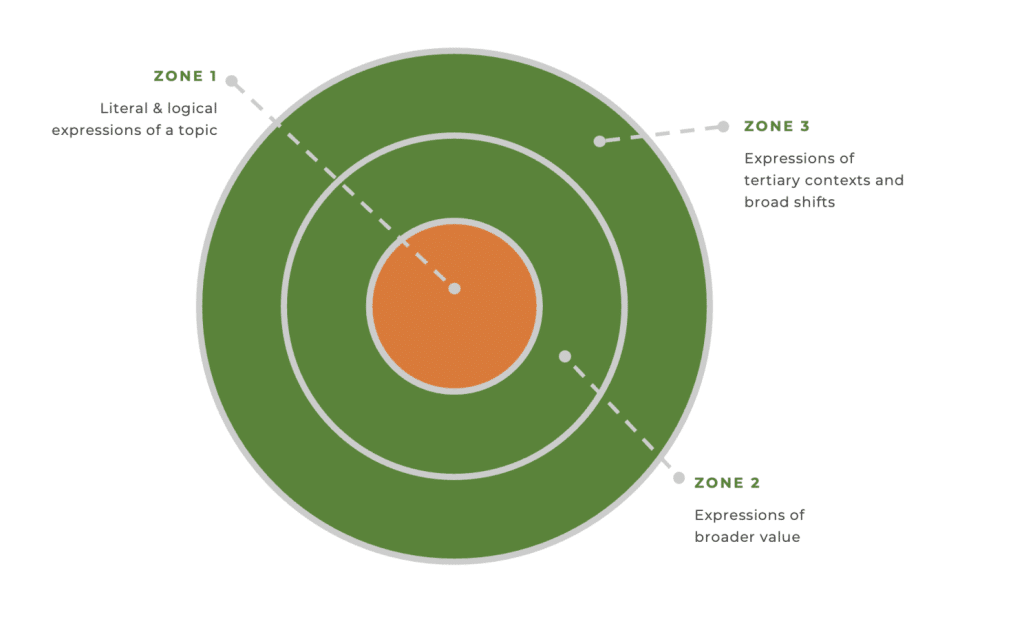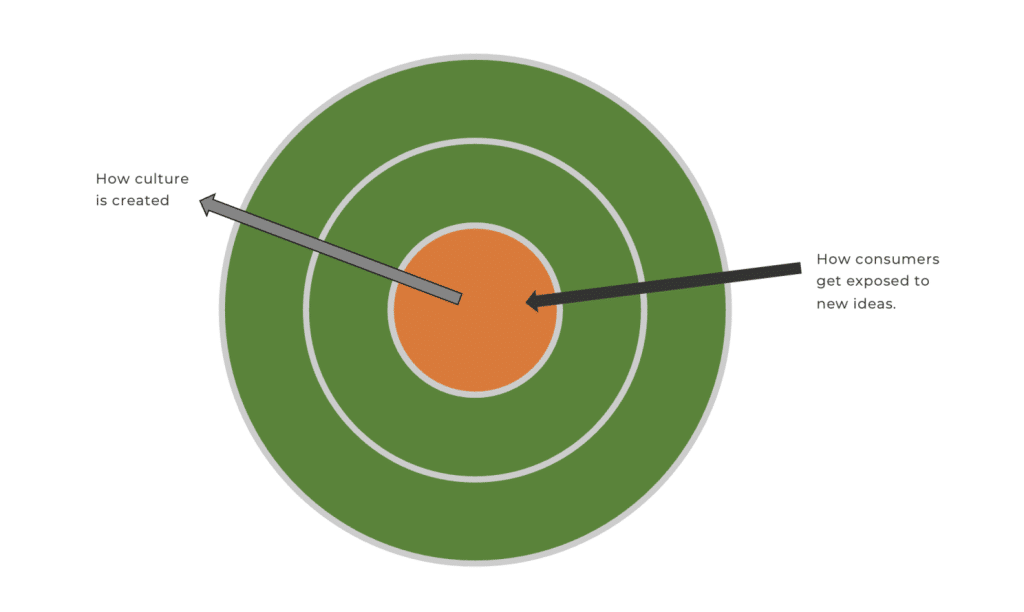In my last blog, I talked about how belief systems need to evolve in order to push new ideas into the mainstream. Since writing that article I’ve been getting a lot of questions from folks about how new people (new consumers) get exposed to emerging trends. So this article is dedicated to unpacking the consumer side of the experience.
To help explain how new consumers flock to emerging trends, we need to understand the natural structure of language make-up around a topic.
You see the contextual map of language around any topic in culture self-organizes into three distinct zones of discourse.

Zone 1: Expressions of literal value
The first zone, which is closest to the core of the topic is where consumers discuss the most literal and logical expressions of the topic. In this zone, people discuss the literal value of an idea to them in their lives.
Take the topic of sustainable personal care as an example and you will find that in Zone 1, conversations pertain very logically to forms of packaging or the higher cost of sustainable alternatives.
Zone 2: Expressions of broader value
In the second zone, conversations broaden as people begin to connect the topic to wider areas of purpose. For example, in the context of sustainable personal care, zone 2 is where the conversation begins expanding into areas like impact on skin, impact of ingredients like phthalates on hormones, the use of organic ingredients, and the value of waste reduction.
Zone 3: Expressions of tertiary contexts
In the third zone, conversations broaden even further into tertiary contexts. This is where new consumers first enter the culture of sustainable personal care – by getting exposed to the topic, often indirectly. For example, consumers interested in living healthier lives or interested in exploring wellness and self-care related areas end up getting indirectly exposed to sustainable personal care. Often these consumers during initial exposure may not even be aware that they are getting exposed to a whole new culture or set of trends. But that is how it goes. New consumers are drawn into a context as the topic begins to expand in popularity. And as consumers make their way from Zone 3 toward Zone 1, they get gradually more exposed to the topic and gain knowledge and an understanding of what it is and what value it brings to their lives and routines.

All this of course happens as the language in each of the three zones also continues to evolve as a topic continues to mature. For more on this revisit my last blog post. Which is why context is such a critical ingredient in structural anthropology. Without an understanding of context, we would not be able to apply anthropology in such a manner so as to not only identify how cultures are changing but also model its size and rate of evolution.
Implications for Innovation
Organizations often try to go-to-market with Zone 1 and Zone 3 actions. They understand literal expressions of a product or category because you can use any kind of data science and even ask consumers to uncover them. Organizations have also become quite good at tracking or at least paying attention to broader cultural shifts that their brands might need to connect with or exist within. But where they lack the most insight is in Zone 2, which is not only the zone where new ideas turn into broader platforms of opportunity in the mind of the consumer, but it is also the zone where we learn how to connect product specific insight to broader cultural shifts in society.
It is the zone that connects the dots.
Zone 2 is where new platforms are created. For example, in the area of sustainable personal care, it is in Zone 2 that we discover new platforms for innovation around zero waste packaging (rethinking the opportunity in bioplastics for example), or stress relief (soothing ingredients and design that promotes new habit formation).
Zone 2 is truly where inspiration lives and where competitive advantage is often had. Yet it is also one of the most ignored areas of any kind of trend analysis. Which is again why understanding the makeup of language maps and the journey of the consumer in discovery can be so transformational to insights and innovation teams. Without an understanding of how trends naturally shape and evolve and how they bring new consumers along for the ride, we cannot truly scale our insight-to-innovation workflow. It is then needless to say that understanding how new consumers get exposed to emerging trends can transform an organization’s ability to reinvigorate tired old spaces, and create tangible action against new and less defined spaces.
